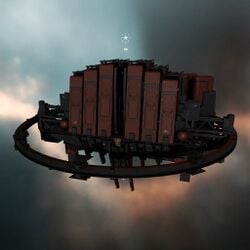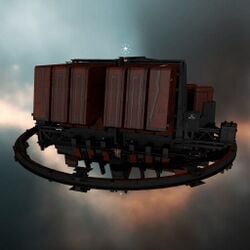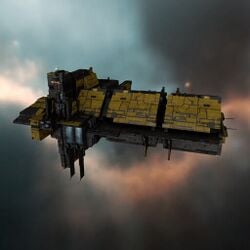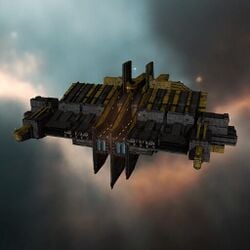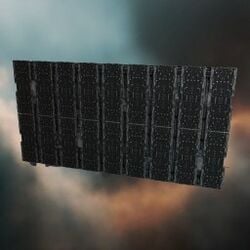More actions
Keyroii Moru (talk | contribs) m Palatine Keepstar has been removed from the singularity test server, also updated the year of no yet anchored palatin keepstar. |
|||
| (88 intermediate revisions by 43 users not shown) | |||
| Line 1: | Line 1: | ||
{{structures | {{structures}} | ||
== | '''Upwell Structures''' are large player-made structures. They provide services and docking facilities which in many ways mirror those provided by NPC stations, but they differ somewhat in their mechanics. In some respects they are more useful than NPC stations, but on the other hand they can be destroyed. | ||
Upwell structures | |||
In high- and low-security space, Upwell structures are useful tools for corporations; in null-security space and even more so in [[wormholes]], they can be essential bases and semi-permanent homes for players. | |||
== Construction == | |||
Much like anything else, Upwell structures are manufactured out of sub-components. Structure components can be either bought from the market, built in stations or other upwell structures. The final assembly of the structures can take place in either a station or a structure. Structure components are distinguished by their usage of a good bit of Planetary Industry materials in their construction. | |||
== Deploying an Upwell Structure == | |||
After construction the structure needs to be taken to the desired location in space and deployed. Corporations must be at least 7 days old to anchor a structure. Certain solar systems are blocked including Trade Hubs, Career Agent Systems, New Player Starter Systems, Shattered Wormholes and Thera. XL structures, includes Keepstars and Sotiyos, cannot be anchored in High-Security space. The structure must be at least 1,000 KM away from other stations, gates, etc. See [[Anchoring structures]] for more details | |||
To fully deploy the structure in an online state, a [[Quantum Cores|quantum core]], at least one [[Fitting upwell structures|service module]], and [https://everef.net/groups/1136 fuel blocks] are required. The quantum core is installed by: | |||
# dock up with the structure | |||
# taking control of it | |||
# opening the quantum room | |||
# placing the quantum core in the slot | |||
Structures deployed before quantum cores were added may still not have a core (depending on if their owners have decided to install one or not). If they do not they will work as normal but will lack tethering, ship fitting, and repair services. | |||
== Access Rights == | |||
{{main|Structure permissions}} | |||
Access rights to an Upwell Structure are organized through the '''Access Lists''' UI through the Neocom menu. Access Lists contain profiles which grants access to the list of people who are within said profile. Because Upwell Structures can only be deployed by members of player owned corporations, that corporation will have a default access list that other capsuleers cannot be added to. There are four levels of rights that can be given to users: Administrator (can add or remove members of any level), Manager (can add individual members, corporations or alliances), Member and Blocked. The administrators and managers of a list are the only ones who have access to view and modify their respective lists. | |||
To grant a capsuleer rights to an Upwell Structure they must be added to the access list via the "Add Members" button. Although characters, corporations and alliances may be added through this method, if the capsuleer is part of an NPC corporation or faction then they must be added individually. | |||
Upwell structures can also be set to grant public access. In such case the structure access list may also be effectively used as a deny list. To deny a capsuleer access rights to an Upwell Structure, the capsuleer must be added to the access list and set to "blocked". | |||
== Upwell Structures == | |||
==Citadels== | === Citadels === | ||
Citadels are | Citadels are Upwell Structures meant to be used as operation bases. They receive bonuses to combat rig effectiveness, market service fuel usage and cloning bay fuel usage. Citadels also have the shortest vulnerability durations and strongest combat options making them easier to defend. | ||
The three citadels are Astrahus (medium), Fortizar (large) and Keepstar (extra large). They have exactly same structure bonuses so the difference is only how | The three citadels are Astrahus (medium), Fortizar (large) and Keepstar (extra large). They have exactly same structure bonuses so the difference is only how many things they can have fitted and how much of a status symbol they are. | ||
There is also special Upwell Palatine Keepstar extra-large citadel. This citadel has ridiculously high material requirements and only one can be deployed at any given time. | There is also a special Upwell ''Palatine'' Keepstar extra-large citadel. This citadel has ridiculously high material requirements, estimated at around 100 Trillion ISK and only one can be deployed at any given time. As of 2025 no one has anchored a Palatine Keepstar. | ||
<div style="display: flex; flex-wrap: wrap;"> | |||
<div>[[File:astrahus.jpg|thumb|250px|'''Astrahus''' (medium)]]</div> | |||
<div>[[File:fortizar.jpg|thumb|250px|'''Fortizar''' (large)]]</div> | |||
<div>[[File:keepstar.jpg|thumb|250px|'''Keepstar''' (extra-large)]]</div> | |||
</div> | |||
{|class="wikitable | {| class="wikitable" style="text-align: center;" | ||
|- style="background-color: var(--background-color-warning-subtle)" | |||
!colspan= | ! rowspan=2 | Structure | ||
!colspan=" | ! colspan=2 style="text-align: center;" | Role bonuses | ||
! | ! colspan=4 style="text-align: center;" | Attributes | ||
! | |- style="background-color: var(--background-color-neutral)" | ||
! [[File:Icon missile rig.png|21px|Combat rig effectiveness bonus]] | |||
! [[File:Gallente fuel block.png|21px|Citadel service module fuel usage]] | |||
! style="border-left: var(--border-subtle);" | [[File:Icon service slot.png|21px|Service slots]] | |||
! Max docking | |||
! Extra | |||
|- | |- | ||
|Astrahus | |Astrahus | ||
|25% | |25% | ||
| | |25% | ||
|3 | |3 | ||
|subcapital | |||
| | |||
|- | |- | ||
| | |Fortizar | ||
|25 | |25% | ||
|25% | |25% | ||
| | |5 | ||
| | |capital | ||
| | |||
|- | |- | ||
| | |Keepstar | ||
|25 | |25% | ||
|25% | |25% | ||
| | |7 | ||
|supercapital | |||
|Can use doomsday weapon | |||
|} | |} | ||
==Refineries== | === Faction Fortizars === | ||
Refineries are structures of choice for refining materials, reactions and moon mining. These are the only structures that can do reactions or moon mining and also receive innate bonuses to refining | The advanced Faction upgraded Fortizars are special edition structures released in limited numbers to capsuleers by the Upwell Consortium as part of their outpost migration project of YC120. During the outpost migration event all Outposts and Conquerable stations were converted into these new faction Fortizars, and after that event no more copies of these structures or their blueprints have been made available to capsuleers. Faction Fortizars still existing in their original spot and never unanchored or destroyed have special unique rigs with enhanced bonuses. | ||
There are 5 types of Faction Fortizars, one for each of the four former outpost types (Null-Sec stations deployed by player alliances), and one for the Immensea conquerable stations. | |||
=== Refineries === | |||
Refineries are structures of choice for refining materials, reactions and moon mining. These are the only structures that can do reactions or moon mining and also receive innate bonuses to refining yields and both reprocessing and refining service module fuel consumption. You can find the exact formula for Upwell refining bonuses [[Reprocessing#Upwell_reprocessing_formula|here]]. | |||
The two refineries are Athanor (medium) and Tatara (large). The | The two refineries are Athanor (medium) and Tatara (large). The Athanor docking is limited to only subcapitals while Tatara also allows [[Rorqual]]s to dock. | ||
{|class="wikitable | <div style="display: flex; flex-wrap: wrap;"> | ||
<div>[[File:Athanor.jpg|thumb|250px|'''Athanor''' (medium)]]</div> | |||
!colspan= | <div>[[File:Tatara.jpg|thumb|250px|'''Tatara''' (large)]]</div> | ||
!colspan=" | </div> | ||
! | |||
! | {|class="wikitable" style="text-align: center;" | ||
! | |- style="background-color: var(--background-color-warning-subtle)" | ||
! rowspan=2 | Structure | |||
! colspan=3 style="text-align: center;" | Role bonuses | |||
! colspan=4 style="text-align: center;" | Attributes | |||
|- style="background-color: var(--background-color-neutral)" | |||
! [[File:Reprocess.png|21px|Refinery yeld]] | |||
! [[File:Gallente fuel block.png|21px|Refining/reaction service fuel usage reduction]] | |||
! [[File:Icon reaction.png|21px|Reaction job duration reduction]] | |||
! style="border-left: var(--border-subtle);" | [[File:Icon service slot.png|21px|Service slots]] | |||
! Max docking | |||
! Extra | |||
|- | |- | ||
| Line 91: | Line 111: | ||
|20% | |20% | ||
| | | | ||
|3 | |||
|subcapital | |||
| | | | ||
|- | |- | ||
| Line 99: | Line 120: | ||
|25% | |25% | ||
|25% | |25% | ||
| | |5 | ||
| | |subcapital | ||
|Rorqual can dock | |||
|} | |} | ||
==== Moon mining ==== | |||
{{main|Moon mining}} | |||
Moon mining can take place only at refineries anchored within 250 km of a mining beacon and fitted with a Standup Moon Drill I service module, which appears on the outside of the structure as a '''''giant laser turret''''' aimed at the moon. A single cycle takes between 6 and 56 days depending on setup. The steps are as follows: | |||
# Anchor the structure within 250 km of moon mining beacon. The beacon can be warped to from the right click menu in space. Only one refinery can be placed within range of the beacon. | |||
# Set the length of the desired mining cycle. The amount of ore brought up with each cycle is directly proportional to the cycle time (30k m³ per hour), so choose whatever works best for your schedule | |||
# Fire the laser at the moon. This will break off a chunk of the moon and allow it to be pulled away from the surface. | |||
# The mining turret's tractor beam will gradually pull the chunk away from the surface. It will continue to move into position until the time you specified in step 2. | |||
# Fire the laser again, this time at the moon chunk. It will explode into a lot of little chunks, or asteroids. | |||
# Send forth your <s>minions</s> miners to mine the asteroid belt. Have them bring it back to the refinery to turn it into precious moon goo. | |||
# While your miners are busy killing rocks, you can get started setting up the next cycle. | |||
Savvy players may note that this results in much more risky game-play than previous moon mining mechanics. The predictable timing of mining cycles combined with the high value of moon ores makes moon mining belts a prime target for pirates. Refinery operators should prepare a response against any attacks, as well as dealing with ninja miners attempting to steal moon ore. | |||
=== Engineering complexes === | |||
Engineering complexes are the structures of choice for research and manufacturing. Research and manufacturing services installed in engineering complexes consume less fuel. In addition the engineering complexes have innate bonuses to manufacturing material usage, manufacturing and science job durations and manufacturing and science job installation fees. | |||
The three engineering complexes are Raitaru (medium), Azbel (large) and Sotiyo (extra-large). The Raitaru can only build and dock subcapitals. The Azbel can build up to capitals, but it can only dock subcapitals, so once a built capital leaves, it cannot go back in. The Sotiyo can dock up to capitals, but it can also build supercapitals. However, built supercapitals cannot reenter a Sotiyo after they undock. | |||
<div style="display: flex; flex-wrap: wrap;"> | |||
<div> [[File:raitaru.jpg|thumb|250px|'''Raitaru''' (medium)]] </div> | |||
<div> [[File:azbel.jpg|thumb|250px|'''Azbel''' (large)]] </div> | |||
<div> [[File:sotiyo.jpg|thumb|250px|'''Sotiyo''' (extra-large)]] </div> | |||
</div> | |||
{|class="wikitable | {|class="wikitable" style="text-align: center;" | ||
|- style="background-color: var(--background-color-warning-subtle)" | |||
!colspan= | ! rowspan=2 | Structure | ||
!colspan=" | ! colspan=4 style="text-align: center;" | Role bonuses | ||
! | ! colspan=4 style="text-align: center;" | Attributes | ||
! | |- style="background-color: var(--background-color-neutral)" | ||
! | ! [[File:Icon material efficiency.png|17px|Manufacturing material requirement]] | ||
! | ! [[File:Icon time efficiency.png|21px|Manufacturing and science job duration]] | ||
! [[File:Wallet.png|21px|Job fee]] | |||
! [[File:Gallente fuel block.png|21px|Manufacturing and research service module fuel usage]] | |||
! style="border-left: var(--border-subtle);" | [[File:Icon service slot.png|21px|Service slots]] | |||
! Max docking | |||
! Extra | |||
|- | |- | ||
| Line 141: | Line 169: | ||
|3% | |3% | ||
|25% | |25% | ||
|3 | |||
|subcapital | |||
| | | | ||
|- | |- | ||
| Line 150: | Line 179: | ||
|4% | |4% | ||
|25% | |25% | ||
|5 | |||
|subcapital | |||
|Can build capitals | |Can build capitals | ||
|- | |- | ||
| | |Sotiyo | ||
|1% | |1% | ||
|30% | |30% | ||
|5% | |5% | ||
|25% | |25% | ||
|Can build supercapitals. | |6 | ||
|subcapital + capital | |||
|Can build supercapitals. * | |||
|} | |} | ||
* Requires "Supercapital Construction Facilities" infrastructure hub upgrade. | |||
=== Navigation structures === | |||
{{main|Navigation structures}} | |||
The Upwell navigation structures are much more specialized. They do not allow tethering or even ship docking. | |||
[[ | <div style="display: flex; flex-wrap: wrap;"> | ||
<div> [[File:ansiblex.jpg|thumb|250px|'''Ansiblex Jump Bridge''']] </div> | |||
<div> [[File:pharolux.jpg|thumb|250px|'''Pharolux Cyno Beacon ''']] </div> | |||
<div> [[File:tenebrex.jpg|thumb|250px|'''Tenebrex Cyno Jammer ''']] </div> | |||
</div> | |||
=== Equinox Upwell structures === | |||
{{main|Orbital Skyhook}} | |||
{{main|Metenox Moon Drill}} | |||
{{main|Sovereignty}} | |||
In the Equinox Update for EVE, additional Upwell Structures<ref>https://www.eveonline.com/news/view/equinox-expansion-notes</ref> were added - the Orbital Skyhook, Metenox Moon Drill, and the Sovereignty Hub, which replaced Territorial Control Units in SovNull space. Like Navigational Structures, these structures cannot be docked with, and provide additional benefits instead | |||
<div style="display: flex; flex-wrap: wrap;"> | |||
<div> [[File:Skyhook.jpg|thumb|250px|alt=Orbital Skyhook|thumb|'''Orbital Skyhook''']] </div> | |||
<div> [[File:Metenox Moon Drill.jpg|thumb|250px|alt=Metenox Moon Drill|thumb|'''Metenox Moon Drill''']] </div> | |||
<div> [[File:Sovereignty Hub.jpg|thumb|250px|alt=Sovereignty Hub|thumb|'''Sovereignty Hub''']] </div> | |||
</div> | |||
== | == Advantages of Upwell Structures == | ||
Upwell are comparable to NPC stations but with multiple distinct advantages. | |||
[[Tethering]] allows pilots to sit in immediate vicinity of a friendly structure. This has multiple benefits: | |||
* Warping to the structure is safe as you tether immediately after landing (if you have a weapons timer, you will NOT tether until the timer expires). | |||
* Warping away is safe as you will do the aligning while tethered. | |||
* Large tether radius makes it very hard to bubble whole structure. | |||
An Upwell structure with clone bay allows capsuleers to swap clones without cool-down period. To do this you need to be in the same structure as your target clone. | |||
The engineering complexes and refineries have significant bonuses that give them edge over stations. Additionally the Upwell Structures can fit manufacturing, research and refining rigs to further augment structure strengths. | |||
Upwell structures can be [[Fitting upwell structures|fitted]] with offensive capabilities. | |||
== Upwell Structure Services == | |||
Upwell structures have wide variety of services available in them. Some services are available even in an unfitted structure but most services require a specific service module to be fitted. | |||
Services always available: | |||
* Tethering (If structure is not in "Abandoned" state, and has a core) | |||
* Hangar | |||
* Ship fitting (Core required) | |||
* Insurance | |||
* Repair shop (Core required) | |||
* Contracts, direct trading and deliveries | |||
* Corporation offices | |||
Services available as service modules. These services all require fuel to stay online. | |||
* Market | |||
* Clone bay | |||
* Reprocessing | |||
* Blueprint research | |||
* Invention | |||
* Manufacturing | |||
* Capital ship manufacturing | |||
* Super-capital ship manufacturing | |||
* Booster reactions | |||
* Composite reactions | |||
* Hybrid reactions | |||
* Moon mining | |||
As these services require an active module to stay online, the service will go offline if there is not enough fuel. Offline service will pause all manufacturing jobs, stop market activity and lock any clones installed at the structure; the materials and clones that were inside are not destroyed but they can not be recovered unless the service is brought back online. The industry/research jobs can be cancelled but this will not return any of the materials. | |||
Moon mining, reactions and (super)capital manufacturing services are the only ones with restrictions. All others can be installed in any Upwell Structure. The clone bay has additional limitations if fitted in wormhole space. You can not jump into a structure in wormhole space so the clone bay is limited to clone swapping (this includes medical clones). | |||
== Finding Structures == | |||
[[File:structure_browser.png|thumb|Structure Browser]] | |||
The '''Structure Browser''' is able to show you info on structures in same system, same constellation or same region as where you are. It has information about what structures and stations are accessible and what services they offer. You can find the structure browser in the [[NeoCom]] under "Utilities" or by hitting the {{button|Esc}}-button and setting up a shortcut for it. | |||
While you are in space your overview will show all citadels that you have docking rights for. Citadels that are on grid are shown even if no docking rights are available. | |||
Citadels to which you don't have docking rights are visible in solar map in brackets. | |||
[[ | == History == | ||
Upwell structures were introduced to replace [[Player-owned starbases]] and outposts, although starbases have yet to be removed from the game. | |||
There | There have been numerous changes and additions to Upwell structures over the years: | ||
* The first upwell structures to be introduced were the Citadels (Astrahus, Fortizar, Keepstar and Upwell Palatine Keepstar) in the [[Expansions#Citadel|Citadel]] expansion on April 27, 2016.<ref>https://www.eveonline.com/news/view/patch-notes-for-eve-online-citadel</ref> With them the cloning, market, and reprocessing service modules were introduced. | |||
* The engineering complexes (Raitaru, Azbel, and Sotiyo) were introduced in the [[Expansions#Ascension|Ascension]] expansion on November 15, 2016.<ref>https://www.eveonline.com/news/view/patch-notes-for-eve-online-ascension</ref> At the same time the engineering service modules were introduced.<ref>https://www.eveonline.com/news/view/building-dreams-introducing-engineering-complexes</ref> | |||
* | * The refineries (Athanor and Tatara) were added in the [[Expansions#Lifeblood|Lifeblood]] expansion on October 24, 2017.<ref>https://www.eveonline.com/news/view/patch-notes-for-eve-online-lifeblood</ref> Reprocessing rigs fitted to Upwell structures before that expansion were automatically unfitted so that the players could put them on the new refineries. The refineries replaced POSs for moon mining and reactions. | ||
* In the February 2018 release the mechanics for Upwell Structures received an overhaul. Most notably low power states were introduced.<ref>https://www.eveonline.com/news/view/patch-notes-for-february-2018-release-1-0 and https://www.eveonline.com/news/view/upwell-2.0-structures-changes-coming-on-february-13th</ref> | |||
* On June 5, 2018 the faction Fortizars - 'Draccous' Fortizar, 'Horizon' Fortizar, 'Marginis' Fortizar, 'Moreau' Fortizar, and 'Prometheus' Fortizar - were introduced. All outposts in the game automatically turned into their corresponding faction Fortizar version.<ref>https://www.eveonline.com/news/view/patch-notes-for-eve-online-into-the-abyss and https://www.eveonline.com/news/view/faction-citadels-the-details</ref> | |||
[[ | * The navigation structures Ansiblex Jump Bridge, Pharolux Cyno Beacon, and Tenebrex Cyno Jammer were introduced in the [[Expansions#Onslaught|Onslaught]] expansion on November 13, 2018. | ||
* Keepstars and Sotiyos can no longer be anchored in High-Security space as of June 14th, 2023. <ref>https://www.eveonline.com/news/view/patch-notes-version-21-05</ref> | |||
[[ | == References and Further Reading == | ||
* [https://support.eveonline.com/hc/en-us/sections/201103521-Player-Owned-Structures CCP's Helpdesk Articles on Player Owned Structures]. | |||
* Expansion notes [https://www.eveonline.com/news/view/equinox-expansion-notes#h2-2 Equinox] | |||
<references /> | |||
{{Structure_Links}} | |||
[[Category:Structures]] | |||
Latest revision as of 18:05, 23 October 2025

|
| Upwell |
|---|
| Mechanics |
| CCP's Helpdesk |
Upwell Structures are large player-made structures. They provide services and docking facilities which in many ways mirror those provided by NPC stations, but they differ somewhat in their mechanics. In some respects they are more useful than NPC stations, but on the other hand they can be destroyed.
In high- and low-security space, Upwell structures are useful tools for corporations; in null-security space and even more so in wormholes, they can be essential bases and semi-permanent homes for players.
Construction
Much like anything else, Upwell structures are manufactured out of sub-components. Structure components can be either bought from the market, built in stations or other upwell structures. The final assembly of the structures can take place in either a station or a structure. Structure components are distinguished by their usage of a good bit of Planetary Industry materials in their construction.
Deploying an Upwell Structure
After construction the structure needs to be taken to the desired location in space and deployed. Corporations must be at least 7 days old to anchor a structure. Certain solar systems are blocked including Trade Hubs, Career Agent Systems, New Player Starter Systems, Shattered Wormholes and Thera. XL structures, includes Keepstars and Sotiyos, cannot be anchored in High-Security space. The structure must be at least 1,000 KM away from other stations, gates, etc. See Anchoring structures for more details
To fully deploy the structure in an online state, a quantum core, at least one service module, and fuel blocks are required. The quantum core is installed by:
- dock up with the structure
- taking control of it
- opening the quantum room
- placing the quantum core in the slot
Structures deployed before quantum cores were added may still not have a core (depending on if their owners have decided to install one or not). If they do not they will work as normal but will lack tethering, ship fitting, and repair services.
Access Rights
- Main article: Structure permissions
Access rights to an Upwell Structure are organized through the Access Lists UI through the Neocom menu. Access Lists contain profiles which grants access to the list of people who are within said profile. Because Upwell Structures can only be deployed by members of player owned corporations, that corporation will have a default access list that other capsuleers cannot be added to. There are four levels of rights that can be given to users: Administrator (can add or remove members of any level), Manager (can add individual members, corporations or alliances), Member and Blocked. The administrators and managers of a list are the only ones who have access to view and modify their respective lists.
To grant a capsuleer rights to an Upwell Structure they must be added to the access list via the "Add Members" button. Although characters, corporations and alliances may be added through this method, if the capsuleer is part of an NPC corporation or faction then they must be added individually.
Upwell structures can also be set to grant public access. In such case the structure access list may also be effectively used as a deny list. To deny a capsuleer access rights to an Upwell Structure, the capsuleer must be added to the access list and set to "blocked".
Upwell Structures
Citadels
Citadels are Upwell Structures meant to be used as operation bases. They receive bonuses to combat rig effectiveness, market service fuel usage and cloning bay fuel usage. Citadels also have the shortest vulnerability durations and strongest combat options making them easier to defend.
The three citadels are Astrahus (medium), Fortizar (large) and Keepstar (extra large). They have exactly same structure bonuses so the difference is only how many things they can have fitted and how much of a status symbol they are.
There is also a special Upwell Palatine Keepstar extra-large citadel. This citadel has ridiculously high material requirements, estimated at around 100 Trillion ISK and only one can be deployed at any given time. As of 2025 no one has anchored a Palatine Keepstar.
| Structure | Role bonuses | Attributes | ||||
|---|---|---|---|---|---|---|
| Max docking | Extra | |||||
| Astrahus | 25% | 25% | 3 | subcapital | ||
| Fortizar | 25% | 25% | 5 | capital | ||
| Keepstar | 25% | 25% | 7 | supercapital | Can use doomsday weapon | |
Faction Fortizars
The advanced Faction upgraded Fortizars are special edition structures released in limited numbers to capsuleers by the Upwell Consortium as part of their outpost migration project of YC120. During the outpost migration event all Outposts and Conquerable stations were converted into these new faction Fortizars, and after that event no more copies of these structures or their blueprints have been made available to capsuleers. Faction Fortizars still existing in their original spot and never unanchored or destroyed have special unique rigs with enhanced bonuses.
There are 5 types of Faction Fortizars, one for each of the four former outpost types (Null-Sec stations deployed by player alliances), and one for the Immensea conquerable stations.
Refineries
Refineries are structures of choice for refining materials, reactions and moon mining. These are the only structures that can do reactions or moon mining and also receive innate bonuses to refining yields and both reprocessing and refining service module fuel consumption. You can find the exact formula for Upwell refining bonuses here.
The two refineries are Athanor (medium) and Tatara (large). The Athanor docking is limited to only subcapitals while Tatara also allows Rorquals to dock.
| Structure | Role bonuses | Attributes | |||||
|---|---|---|---|---|---|---|---|
| Max docking | Extra | ||||||
| Athanor | 2% | 20% | 3 | subcapital | |||
| Tatara | 4% | 25% | 25% | 5 | subcapital | Rorqual can dock | |
Moon mining
- Main article: Moon mining
Moon mining can take place only at refineries anchored within 250 km of a mining beacon and fitted with a Standup Moon Drill I service module, which appears on the outside of the structure as a giant laser turret aimed at the moon. A single cycle takes between 6 and 56 days depending on setup. The steps are as follows:
- Anchor the structure within 250 km of moon mining beacon. The beacon can be warped to from the right click menu in space. Only one refinery can be placed within range of the beacon.
- Set the length of the desired mining cycle. The amount of ore brought up with each cycle is directly proportional to the cycle time (30k m³ per hour), so choose whatever works best for your schedule
- Fire the laser at the moon. This will break off a chunk of the moon and allow it to be pulled away from the surface.
- The mining turret's tractor beam will gradually pull the chunk away from the surface. It will continue to move into position until the time you specified in step 2.
- Fire the laser again, this time at the moon chunk. It will explode into a lot of little chunks, or asteroids.
- Send forth your
minionsminers to mine the asteroid belt. Have them bring it back to the refinery to turn it into precious moon goo. - While your miners are busy killing rocks, you can get started setting up the next cycle.
Savvy players may note that this results in much more risky game-play than previous moon mining mechanics. The predictable timing of mining cycles combined with the high value of moon ores makes moon mining belts a prime target for pirates. Refinery operators should prepare a response against any attacks, as well as dealing with ninja miners attempting to steal moon ore.
Engineering complexes
Engineering complexes are the structures of choice for research and manufacturing. Research and manufacturing services installed in engineering complexes consume less fuel. In addition the engineering complexes have innate bonuses to manufacturing material usage, manufacturing and science job durations and manufacturing and science job installation fees.
The three engineering complexes are Raitaru (medium), Azbel (large) and Sotiyo (extra-large). The Raitaru can only build and dock subcapitals. The Azbel can build up to capitals, but it can only dock subcapitals, so once a built capital leaves, it cannot go back in. The Sotiyo can dock up to capitals, but it can also build supercapitals. However, built supercapitals cannot reenter a Sotiyo after they undock.
* Requires "Supercapital Construction Facilities" infrastructure hub upgrade.
- Main article: Navigation structures
The Upwell navigation structures are much more specialized. They do not allow tethering or even ship docking.
Equinox Upwell structures
- Main article: Orbital Skyhook
- Main article: Metenox Moon Drill
- Main article: Sovereignty
In the Equinox Update for EVE, additional Upwell Structures[1] were added - the Orbital Skyhook, Metenox Moon Drill, and the Sovereignty Hub, which replaced Territorial Control Units in SovNull space. Like Navigational Structures, these structures cannot be docked with, and provide additional benefits instead
Advantages of Upwell Structures
Upwell are comparable to NPC stations but with multiple distinct advantages.
Tethering allows pilots to sit in immediate vicinity of a friendly structure. This has multiple benefits:
- Warping to the structure is safe as you tether immediately after landing (if you have a weapons timer, you will NOT tether until the timer expires).
- Warping away is safe as you will do the aligning while tethered.
- Large tether radius makes it very hard to bubble whole structure.
An Upwell structure with clone bay allows capsuleers to swap clones without cool-down period. To do this you need to be in the same structure as your target clone.
The engineering complexes and refineries have significant bonuses that give them edge over stations. Additionally the Upwell Structures can fit manufacturing, research and refining rigs to further augment structure strengths.
Upwell structures can be fitted with offensive capabilities.
Upwell Structure Services
Upwell structures have wide variety of services available in them. Some services are available even in an unfitted structure but most services require a specific service module to be fitted.
Services always available:
- Tethering (If structure is not in "Abandoned" state, and has a core)
- Hangar
- Ship fitting (Core required)
- Insurance
- Repair shop (Core required)
- Contracts, direct trading and deliveries
- Corporation offices
Services available as service modules. These services all require fuel to stay online.
- Market
- Clone bay
- Reprocessing
- Blueprint research
- Invention
- Manufacturing
- Capital ship manufacturing
- Super-capital ship manufacturing
- Booster reactions
- Composite reactions
- Hybrid reactions
- Moon mining
As these services require an active module to stay online, the service will go offline if there is not enough fuel. Offline service will pause all manufacturing jobs, stop market activity and lock any clones installed at the structure; the materials and clones that were inside are not destroyed but they can not be recovered unless the service is brought back online. The industry/research jobs can be cancelled but this will not return any of the materials.
Moon mining, reactions and (super)capital manufacturing services are the only ones with restrictions. All others can be installed in any Upwell Structure. The clone bay has additional limitations if fitted in wormhole space. You can not jump into a structure in wormhole space so the clone bay is limited to clone swapping (this includes medical clones).
Finding Structures
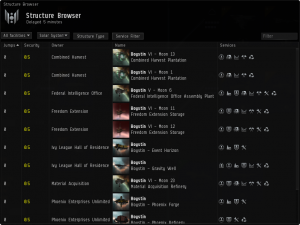
The Structure Browser is able to show you info on structures in same system, same constellation or same region as where you are. It has information about what structures and stations are accessible and what services they offer. You can find the structure browser in the NeoCom under "Utilities" or by hitting the Esc-button and setting up a shortcut for it.
While you are in space your overview will show all citadels that you have docking rights for. Citadels that are on grid are shown even if no docking rights are available.
Citadels to which you don't have docking rights are visible in solar map in brackets.
History
Upwell structures were introduced to replace Player-owned starbases and outposts, although starbases have yet to be removed from the game.
There have been numerous changes and additions to Upwell structures over the years:
- The first upwell structures to be introduced were the Citadels (Astrahus, Fortizar, Keepstar and Upwell Palatine Keepstar) in the Citadel expansion on April 27, 2016.[2] With them the cloning, market, and reprocessing service modules were introduced.
- The engineering complexes (Raitaru, Azbel, and Sotiyo) were introduced in the Ascension expansion on November 15, 2016.[3] At the same time the engineering service modules were introduced.[4]
- The refineries (Athanor and Tatara) were added in the Lifeblood expansion on October 24, 2017.[5] Reprocessing rigs fitted to Upwell structures before that expansion were automatically unfitted so that the players could put them on the new refineries. The refineries replaced POSs for moon mining and reactions.
- In the February 2018 release the mechanics for Upwell Structures received an overhaul. Most notably low power states were introduced.[6]
- On June 5, 2018 the faction Fortizars - 'Draccous' Fortizar, 'Horizon' Fortizar, 'Marginis' Fortizar, 'Moreau' Fortizar, and 'Prometheus' Fortizar - were introduced. All outposts in the game automatically turned into their corresponding faction Fortizar version.[7]
- The navigation structures Ansiblex Jump Bridge, Pharolux Cyno Beacon, and Tenebrex Cyno Jammer were introduced in the Onslaught expansion on November 13, 2018.
- Keepstars and Sotiyos can no longer be anchored in High-Security space as of June 14th, 2023. [8]
References and Further Reading
- CCP's Helpdesk Articles on Player Owned Structures.
- Expansion notes Equinox
- ^ https://www.eveonline.com/news/view/equinox-expansion-notes
- ^ https://www.eveonline.com/news/view/patch-notes-for-eve-online-citadel
- ^ https://www.eveonline.com/news/view/patch-notes-for-eve-online-ascension
- ^ https://www.eveonline.com/news/view/building-dreams-introducing-engineering-complexes
- ^ https://www.eveonline.com/news/view/patch-notes-for-eve-online-lifeblood
- ^ https://www.eveonline.com/news/view/patch-notes-for-february-2018-release-1-0 and https://www.eveonline.com/news/view/upwell-2.0-structures-changes-coming-on-february-13th
- ^ https://www.eveonline.com/news/view/patch-notes-for-eve-online-into-the-abyss and https://www.eveonline.com/news/view/faction-citadels-the-details
- ^ https://www.eveonline.com/news/view/patch-notes-version-21-05
| ||||||||||||||




